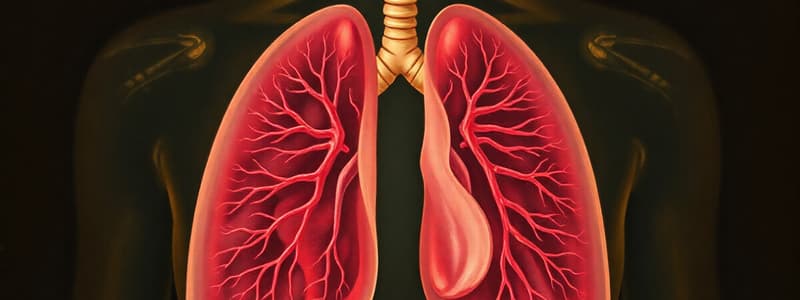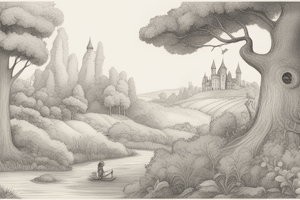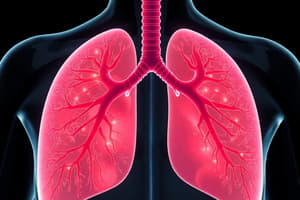Podcast
Questions and Answers
What happens to the volume inside the chest cavity during inhalation?
What happens to the volume inside the chest cavity during inhalation?
- It fluctuates, causing variable air pressure changes.
- It decreases, leading to an increase in air pressure.
- It increases, leading to a decrease in air pressure. (correct)
- It remains the same, allowing for a steady airflow.
Which process occurs when the diaphragm relaxes?
Which process occurs when the diaphragm relaxes?
- Air pressure in the lungs decreases below atmospheric pressure.
- The chest cavity volume increases, allowing air to rush in.
- The ribcage falls down and in, decreasing the chest cavity volume. (correct)
- The alveoli expand to allow more air in.
What is the role of alveoli in the respiratory system?
What is the role of alveoli in the respiratory system?
- To regulate the temperature of the incoming air.
- To facilitate gas exchange between air and blood. (correct)
- To create pressure changes that assist in inhalation.
- To filter impurities from the air before it enters the lungs.
How does oxygen move during the gas exchange process?
How does oxygen move during the gas exchange process?
Which statement correctly describes the process of exhalation?
Which statement correctly describes the process of exhalation?
What is the primary purpose of respiration in living organisms?
What is the primary purpose of respiration in living organisms?
Which of the following best describes aerobic respiration?
Which of the following best describes aerobic respiration?
In the process of building cells, what is the role of amino acids?
In the process of building cells, what is the role of amino acids?
Which structure is responsible for keeping the windpipe open?
Which structure is responsible for keeping the windpipe open?
Why is it better to breathe through the nose rather than the mouth?
Why is it better to breathe through the nose rather than the mouth?
Which side of the heart receives deoxygenated blood from the body?
Which side of the heart receives deoxygenated blood from the body?
What is the primary reason for the left ventricle being thicker than the right ventricle?
What is the primary reason for the left ventricle being thicker than the right ventricle?
Which function do the valves in the heart serve?
Which function do the valves in the heart serve?
Which blood vessel carries oxygenated blood away from the heart?
Which blood vessel carries oxygenated blood away from the heart?
During double circulation, how many times does the blood pass through the heart?
During double circulation, how many times does the blood pass through the heart?
Flashcards
What is respiration?
What is respiration?
Respiration is the process of releasing energy from food. This energy is used for various life processes like growth and movement.
What is aerobic respiration?
What is aerobic respiration?
Aerobic respiration is the release of energy from food using oxygen. This process occurs in the mitochondria of cells.
What are the products of aerobic respiration?
What are the products of aerobic respiration?
The products of aerobic respiration are carbon dioxide, water, and energy. The energy is released as ATP (adenosine triphosphate).
Why do we need respiration?
Why do we need respiration?
Signup and view all the flashcards
What is the function of the diaphragm?
What is the function of the diaphragm?
Signup and view all the flashcards
Double Circulation
Double Circulation
Signup and view all the flashcards
Oxygenated Blood
Oxygenated Blood
Signup and view all the flashcards
Deoxygenated Blood
Deoxygenated Blood
Signup and view all the flashcards
Left Ventricle
Left Ventricle
Signup and view all the flashcards
Valves Prevent Backflow
Valves Prevent Backflow
Signup and view all the flashcards
What happens during inhalation?
What happens during inhalation?
Signup and view all the flashcards
What happens during exhalation?
What happens during exhalation?
Signup and view all the flashcards
Alveoli
Alveoli
Signup and view all the flashcards




